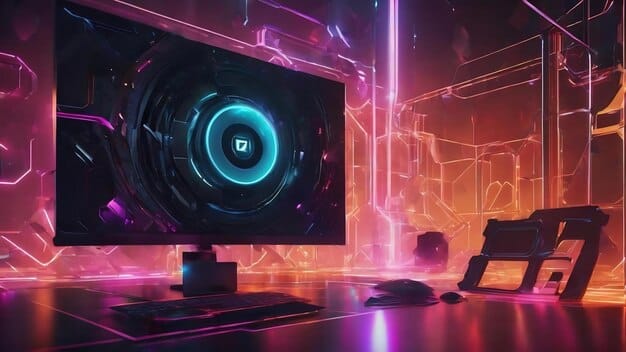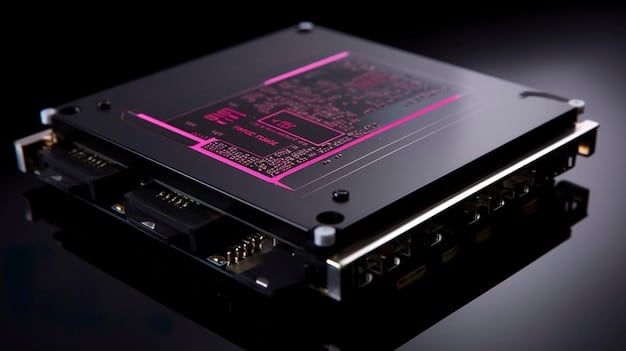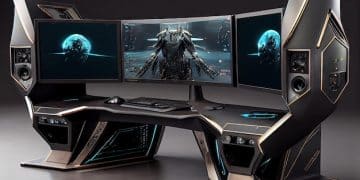Optimize Your PC for 1440p Gaming in 2025: 60+ FPS Guide

Achieving 60+ FPS in 1440p gaming by 2025 requires a strategic upgrade path, focusing on high-performance GPUs, efficient CPUs, optimized RAM configurations, and fast storage, all underpinned by intelligent software and in-game setting adjustments for a superior visual and fluid experience.
As we approach 2025, the dream of fluid 1440p gaming at 60+ frames per second (FPS) becomes increasingly attainable yet still demands a thoughtful approach to hardware and software optimization. This comprehensive guide will help you to Optimize Your PC for 1440p Gaming in 2025: A Data-Driven Guide to Achieving 60+ FPS, ensuring your system delivers an immersive and responsive experience without breaking the bank.
Understanding the Landscape: 1440p Gaming in 2025
1440p, also known as QHD (Quad High Definition), has solidified its position as the sweet spot for PC gaming. It offers a significant visual upgrade over 1080p without the extreme hardware demands of 4K, providing a sharper image and more detailed textures that can greatly enhance immersion. By 2025, game engines and graphics technologies will have evolved further, making efficient hardware choices paramount for consistent 60+ FPS performance.
The goal of 60+ FPS isn’t just about smooth visuals; it’s about responsiveness. Higher frame rates reduce input lag, making games feel more fluid and controlled, which is particularly beneficial in fast-paced competitive titles. Modern displays often support refresh rates of 144Hz or even higher, and reaching 60+ FPS helps to fully utilize these displays, providing a tear-free experience when paired with adaptive sync technologies like G-Sync or FreeSync.
The Shift in Graphics Demands
Game developers are continuously pushing the boundaries of realism, utilizing advanced rendering techniques such as ray tracing, path tracing, and complex shader effects. These technologies, while visually stunning, are also highly demanding on the GPU and, to some extent, the CPU. Therefore, a modern gaming PC for 1440p in 2025 needs to be a balanced machine, with robust components that can handle these computational loads efficiently. The trend indicates that sheer raw power, combined with smart optimization, will be key.
Why 1440p Remains Relevant
While 4K gaming gains traction, 1440p offers a better performance-to-cost ratio. Monitors are generally more affordable, and the hardware required to drive them at high frame rates is less expensive than what’s needed for 4K. This balance makes 1440p an excellent long-term investment for gamers who prioritize both visual fidelity and smooth gameplay without committing to premium 4K-level expenses across the board.
Ultimately, understanding the current and upcoming demands of 1440p gaming is the first step toward building or upgrading a system that will remain competitive and enjoyable for years to come. The components we select and the optimizations we apply will directly influence our ability to sustain those coveted high frame rates.
Key Hardware Components for 1440p Gaming
Building or upgrading a PC for optimal 1440p gaming in 2025 requires a strategic investment in specific hardware components. Each part plays a crucial role in delivering a balanced and high-performance system capable of consistent 60+ FPS. We’ll delve into the essentials, backed by current and projected performance trends.
The synergy between these components is what truly defines a powerful gaming rig. A strong GPU paired with a weak CPU, or vice versa, creates a bottleneck that limits overall performance. Hence, a balanced approach is vital for maximizing your gaming experience.
Graphics Card (GPU) – The Core of 1440p Power
The GPU is undoubtedly the most critical component for 1440p gaming. By 2025, GPUs will have even more advanced architectures and higher VRAM capacities. For 1440p at 60+ FPS, especially with graphic-intensive titles, you should target an upper mid-range to high-end GPU from either NVIDIA or AMD. Based on current trends and anticipated releases, this would likely involve an NVIDIA RTX 50-series (e.g., RTX 5070/5080 equivalents) or an AMD Radeon RX 8000-series (e.g., RX 8700 XT/8800 XT equivalents). Look for GPUs with at least 12GB, but ideally 16GB or more of VRAM to handle future texture packs and ray tracing effects comfortably.
- NVIDIA Options (Projected): RTX 5070, RTX 5080
- AMD Options (Projected): Radeon RX 8700 XT, RX 8800 XT
- VRAM Target: 12GB to 16GB+ for longevity.
Consider the power consumption and cooling requirements of your chosen GPU. High-performance cards generate considerable heat, necessitating a robust cooling solution within your PC case. Adequate airflow and well-placed fans are essential to prevent thermal throttling.
Processor (CPU) – The Game Orchestrator
While the GPU handles most of the graphical heavy lifting, the CPU plays a vital role in game logic, AI, physics, and preparing frames for the GPU. For 1440p gaming, a modern mid-to-high-end CPU from Intel (e.g., Core i7/i9 equivalent from future generations) or AMD (e.g., Ryzen 7/9 8000/9000 equivalent) is recommended. Focus on CPUs with strong single-core performance and at least 6-8 cores for multi-threaded applications and future-proofing. Overclocking potential can also be a bonus for a slight performance edge.
- Intel Options (Projected): Core i7/i9 (e.g. 15th/16th Gen)
- AMD Options (Projected): Ryzen 7/9 (e.g. 8000/9000 Series)
- Core/Thread Count: 6-8 cores, 12-16 threads ideal.
The CPU choice also dictates your motherboard and cooler. Ensure your motherboard supports the chosen CPU socket and has adequate power delivery (VRMs). An efficient air cooler or an All-in-One (AIO) liquid cooler will be necessary to keep temperatures in check under heavy gaming loads.
Random Access Memory (RAM) – Speed and Capacity
For PC gaming in 2025, 16GB of DDR5 RAM should be considered the minimum, with 32GB being the optimal sweet spot for enthusiast gamers. DDR5 offers significantly higher bandwidth and lower latencies compared to DDR4, which benefits modern CPUs and games that increasingly leverage faster memory. Aim for speeds of at least 6000MHz with tight timings (e.g., CL30-34) for the best performance. Dual-channel configurations are essential; avoid single-stick setups.
Storage (SSD) – Faster Loading, Smoother Textures
Long gone are the days of mechanical hard drives for gaming. An NVMe PCIe Gen4 SSD is the absolute minimum for your primary gaming drive. Ideally, by 2025, you should be looking at PCIe Gen5 SSDs for even faster loading times and improved performance in games utilizing technologies like Microsoft’s DirectStorage API, which can load game assets directly to the GPU. A 1TB or 2TB NVMe SSD will provide ample space for your operating system, essential applications, and a healthy library of modern games.

- Primary Drive: NVMe PCIe Gen4 (minimum), PCIe Gen5 (recommended).
- Capacity: 1TB to 2TB for primary drive.
- Benefit: Drastically reduced loading times, smoother texture streaming.
The impact of fast storage extends beyond just loading screens. It can improve texture streaming in open-world games, reducing pop-in and stuttering caused by slow asset loading. This contributes significantly to a more seamless and immersive gaming experience at 1440p.
Optimizing Your Display for 1440p Gaming
Having powerful internal components is only half the battle; the monitor is your window into the game. Choosing and optimizing the right 1440p display is crucial for a truly immersive 60+ FPS gaming experience. By 2025, monitor technology offers a plethora of features that can enhance visual fidelity and responsiveness.
A high-quality 1440p monitor transforms your gaming, allowing you to appreciate the visual details your powerful PC generates. Simply having the frames is not enough if your display can’t render them effectively.
Refresh Rate and Response Time
For 60+ FPS gaming, a monitor with a refresh rate of 120Hz or higher is highly recommended. This allows the display to update more frequently, resulting in smoother motion and reduced motion blur compared to standard 60Hz monitors. Paired with a low response time (1ms GTG is ideal for gaming), you’ll experience minimal ghosting and a crisper image during fast-paced action.
- Refresh Rate: 120Hz, 144Hz, or 165Hz+ for optimal smoothness.
- Response Time: 1ms GTG (Gray-to-Gray) is the benchmark for competitive gaming.
Higher refresh rates directly translate to a more fluid experience, especially noticeable in competitive multiplayer games where every millisecond counts. The difference between 60Hz and 144Hz is immediately apparent and vastly improves gameplay feel.
Adaptive Sync Technologies (G-Sync/FreeSync)
To eliminate screen tearing and stuttering, adaptive sync technologies like NVIDIA G-Sync or AMD FreeSync are indispensable. These technologies synchronize the monitor’s refresh rate with the GPU’s frame output, providing a seamless visual experience. Ensure your chosen monitor supports the adaptive sync technology compatible with your graphics card (G-Sync for NVIDIA, FreeSync for AMD, or ideally, a monitor that supports both via VESA Adaptive Sync).
Adaptive sync makes a monumental difference, especially if your frame rate fluctuates slightly above or below your target. It smooths out these variations, providing a consistently pleasant visual experience without visible interruptions.
Panel Type and Color Accuracy
There are generally three main panel types for gaming monitors: TN, IPS, and VA.
- IPS (In-Plane Switching): Offers the best color accuracy and wider viewing angles, making it excellent for vibrant, immersive gaming. Response times have improved significantly, often rivaling TN panels.
- VA (Vertical Alignment): Provides superior contrast ratios, leading to deeper blacks and richer colors than TN or some IPS panels, albeit with slightly slower response times than the best IPS or TN.
- TN (Twisted Nematic): Traditionally known for the fastest response times and highest refresh rates, but with poorer color reproduction and viewing angles. By 2025, IPS panels often offer similar speeds with better visuals.
For 1440p gaming where visual fidelity is key, an IPS or a high-quality VA panel is generally recommended. IPS panels strike an excellent balance between speed and visual quality, while VA panels provide a more cinematic contrast.
Monitor Size and Curvature
For 1440p, a monitor size between 27 and 32 inches is often considered ideal, providing ample screen real estate without making individual pixels too noticeable. Curved monitors can enhance immersion, especially on wider screens, by better filling your peripheral vision, though this is largely a matter of personal preference.
A larger screen can make the 1440p resolution shine, allowing you to pick out more details and fully appreciate the game world. Experiment with different sizes and curvatures to find what suits your setup and preferences best.
Software and Driver Optimization for Peak Performance
Hardware alone won’t guarantee 60+ FPS at 1440p. Software and driver optimization are equally critical to unlock your PC’s full potential. Neglecting these aspects can lead to performance bottlenecks, even with top-tier components. By 2025, these practices remain fundamental for any serious gamer.
A well-tuned software environment ensures your powerful hardware isn’t held back by inefficient processes or outdated components. It’s about getting the most out of every dollar you’ve invested.
Graphics Drivers: Always Up-to-Date
Graphics drivers from NVIDIA and AMD are continuously updated to provide performance improvements, bug fixes, and optimizations for new game releases. Always ensure you are running the latest stable version of your GPU drivers. Use the official GeForce Experience (NVIDIA) or AMD Software: Adrenalin Edition (AMD) applications to easily manage and update your drivers. Performing a clean installation of new drivers is often recommended to avoid potential conflicts.
- NVIDIA: GeForce Experience for easy updates.
- AMD: AMD Software: Adrenalin Edition for driver management.
- Clean Installation: Crucial for avoiding driver conflicts.
Regular driver updates can significantly boost performance, sometimes by double-digit percentages, especially in newer titles. It’s the easiest and most cost-effective way to get more frames out of your existing hardware.
Operating System Optimization (Windows)
Windows offers several settings that can be tweaked for better gaming performance:
- Game Mode: Ensure Windows Game Mode is enabled. It prioritizes system resources for games.
- Background Apps: Disable unnecessary background applications that consume CPU, RAM, or network bandwidth.
- Power Plan: Set your power plan to “High Performance” or “Ultimate Performance” to prevent your CPU from downclocking during gaming.
- Visual Effects: Adjust Windows visual effects for best performance rather than best appearance through System Properties > Advanced > Performance Settings.
- Notifications: Disable irrelevant notifications during gaming to prevent distractions and resource drain.
In-Game Settings: The Fine Tuning
Every game has an extensive list of graphics settings, and understanding them is key to balancing visual quality and performance. When targeting 1440p at 60+ FPS, some settings have a disproportionately higher impact on performance than others. Experiment with these:
- Shadow Quality: Often a major FPS killer. Reducing shadow quality from Ultra to High or Medium can yield significant gains with minimal visual degradation.
- Volumetric Clouds/Fog: Also very taxing. Adjusting these can improve performance notably.
- Anti-Aliasing: Techniques like MSAA are very demanding. Consider less demanding alternatives like TAA or FXAA, or rely on upscaling technologies if available.
- Ray Tracing: While visually impressive, ray tracing is extremely performance-intensive. Adjusting its quality or disabling it in demanding titles can be necessary to maintain 60+ FPS.
- Upscaling Technologies (DLSS/FSR): Utilize NVIDIA DLSS (Deep Learning Super Sampling) or AMD FSR (FidelityFX Super Resolution) if your GPU supports them. These technologies render the game at a lower resolution and then use AI (DLSS) or spatial upscaling (FSR) to reconstruct the image at 1440p, offering near-native visual quality with substantial FPS boosts.

Start by setting graphical presets to “High” or your GPU’s recommended settings, then incrementally adjust individual settings. Monitor your FPS using tools like MSI Afterburner or a game’s built-in benchmark to see the impact of each change. This methodical approach ensures you find the optimal balance for each game.
Never underestimate the power of fine-tuning your game settings. What might seem like a small adjustment can sometimes provide the necessary boost to push you consistently above that 60 FPS threshold.
Advanced Techniques & Future-Proofing for 2025
Beyond the core components and essential software optimizations, there are advanced techniques and strategic considerations that can further refine your 1440p gaming experience and help future-proof your investment as we head into 2025. These elements focus on squeezing every last drop of performance and preparing for upcoming technological shifts.
Staying ahead of the curve means not just responding to current demands, but anticipating future ones. These advanced strategies will ensure your rig remains formidable.
Overclocking: CPU & GPU
Overclocking your CPU and/or GPU can provide a measurable performance increase, often pushing frame rates higher with minimal cost. However, it requires careful research, adequate cooling, and an understanding of the risks involved. Software like MSI Afterburner (for GPU) or your motherboard’s UEFI/BIOS (for CPU) can be used for overclocking. Always start with small, incremental adjustments and monitor temperatures diligently.
- CPU Overclocking: Can boost clock speeds, improving general system responsiveness and frame generation in some CPU-bound scenarios.
- GPU Overclocking: Increases core clock and memory clock, directly impacting frame rates in most games.
- Caution: Requires robust cooling and stability testing to prevent system crashes or hardware damage.
While not for everyone, a stable overclock can yield extra FPS, especially if you have a component that has headroom for improvement. This can be a cost-effective way to extend the life of your current hardware.
Efficient Cooling Solutions
High-performance components generate significant heat. Effective cooling is paramount to prevent thermal throttling, which can reduce performance and shorten hardware lifespan. Invest in a good CPU cooler (AIO liquid cooler or high-end air cooler) and ensure your PC case has excellent airflow with well-placed intake and exhaust fans. Proper cable management also contributes to unimpeded airflow.
Power Supply Unit (PSU) Considerations
A stable and sufficiently powerful Power Supply Unit (PSU) is often overlooked. Your PSU needs to provide enough wattage for all your components, especially your GPU, under load. Aim for a PSU with at least 80 Plus Gold certification for efficiency and peace of mind. Over-speccing slightly on wattage provides headroom for future upgrades and ensures stable power delivery.
Network Optimization for Online Gaming
While not directly impacting FPS, a stable and fast internet connection with low latency is crucial for online competitive gaming. Use a wired Ethernet connection instead of Wi-Fi whenever possible. Ensure your router is up-to-date and optimize its settings (e.g., Quality of Service or QoS, port forwarding) for gaming if you experience lag.
Future-Proofing Your Build
When selecting components, consider their potential for future compatibility and upgrades. Opting for a motherboard with more PCIe Gen5 slots, additional RAM slots, or a CPU socket that might support future generations can save money in the long run. Choosing a case with good expandability and cooling potential is also a wise decision.
- Modular PSU: Easier cable management and potential for future power needs.
- Motherboard: Look for advanced chipsets supporting future CPU generations and faster I/O.
- Case: Ample space for larger GPUs, more cooling, and future storage.
Investing in higher-quality core components that are built to last and have some upgrade headroom can provide a smoother upgrade path down the line, ensuring your 1440p gaming rig remains relevant for years to come.
Maintaining Your PC for Consistent 1440p Performance
Once your PC is optimized and running smoothly at 1440p, ongoing maintenance is essential to sustain that performance. Neglecting basic upkeep can lead to accumulated clutter, reduced efficiency, and potential hardware issues over time. By 2025, regular maintenance will still be a cornerstone of a reliable gaming experience.
Think of PC maintenance as a marathon, not a sprint. Consistent, small efforts prevent larger issues down the line, ensuring your investment continues to pay off with smooth gameplay.
Regular Software Cleanup
Over time, your operating system and drives can accumulate unnecessary files, temporary data, and redundant software. Regularly:
- Uninstall Unused Programs: Remove applications you no longer use.
- Clear Temporary Files: Use Windows Disk Cleanup or third-party tools to remove temporary internet files, system logs, and old updates.
- Manage Startup Programs: Disable unnecessary programs from launching with Windows to speed up boot times and free up RAM.
A clean software environment ensures that system resources are dedicated to gaming and essential tasks, preventing background processes from siphoning off precious CPU cycles or RAM.
Physical Cleaning and Dust Management
Dust is the enemy of electronics. It acts as an insulator, trapping heat and hindering your cooling system’s efficiency. Build up can lead to higher temperatures, thermal throttling, and potentially shorten component lifespan. At least once every 3-6 months (more often in dusty environments):
- Clean Fans and Radiators: Use compressed air to remove dust from CPU coolers, GPU fans, case fans, and PSU fan vents. Hold fan blades gently to prevent them from spinning too fast.
- Wipe Down Surfaces: Gently clean internal surfaces of the case.
- Check Air Filters: Many modern cases have removable dust filters. Clean these regularly.
This physical maintenance directly contributes to lower operating temperatures and, consequently, more stable and consistent performance. Cooler components run better and last longer.
Monitor Drive Health and Defragmentation (if applicable)
While SSDs don’t require traditional defragmentation, ensuring their health is important. Utilize built-in Windows tools or manufacturer software to monitor SSD health and firmware updates. For any lingering traditional HDDs (though not recommended for gaming), occasional defragmentation can improve file access times.
For SSDs, focus on keeping about 15-20% of the drive free to maintain optimal performance and endurance. This allows the drive controller to perform garbage collection and wear leveling effectively.
Backup Important Data
Though not directly performance-related, regularly backing up your important game saves, configurations, and personal files is a critical maintenance step. Hardware failures can happen, and having backups prevents the loss of hours of progress or irreplaceable data.
Maintaining a clean, cool, and organized PC not only ensures peak 1440p gaming performance but also extends the life of your valuable components, providing a reliable and enjoyable gaming experience well into 2025 and beyond.
Real-World Data: Performance Benchmarks & Targets
When aiming to Optimize Your PC for 1440p Gaming in 2025: A Data-Driven Guide to Achieving 60+ FPS, it’s crucial to look at how various configurations perform in real-world scenarios. General recommendations are helpful, but specific benchmarks provide concrete targets. By 2025, games will be more demanding, making these figures even more important.
Understanding what kind of performance to expect from different hardware tiers allows for informed decisions, ensuring your build aligns with your 60+ FPS goal without overspending or undershooting.
Targeting 60+ FPS Across Genres
Achieving 60+ FPS isn’t a one-size-fits-all scenario. Performance will vary significantly depending on the game, its engine, and the quality settings applied.
- AAA Story-Driven Games (e.g., Cyberpunk 2077, Starfield equivalents): These titles, with their intricate graphics, sprawling worlds, and advanced effects (like ray tracing), are the most demanding. Expect to make some compromises on ultra settings, possibly using DLSS/FSR in “Quality” or “Balanced” mode, to consistently hit 60+ FPS.
- Competitive Multiplayer Games (e.g., Valorant, Apex Legends, CS2 equivalents): These games are often optimized for higher frame rates. A mid-to-high-end GPU should easily push well over 100 FPS, making 144Hz+ monitors fully utilized.
- Esports Titles: Games like League of Legends or DOTA 2 are less graphically intensive and will run at very high frame rates (144+ FPS) even on more modest hardware at 1440p.
Your ultimate goal is to find a balance between visual fidelity and the desired frame rate for the specific games you play most. It’s often better to have consistent 60 FPS on “High” settings than fluctuating 40-70 FPS on “Ultra.”
Expected GPU Performance Tiers (Projected for 2025)
Based on current trends and anticipated generational leaps in GPU technology, here’s a rough breakdown of what future GPUs might offer for 1440p gaming:
| GPU Tier (Projected) | Expected 1440p FPS (High/Ultra) | Notes |
|---|---|---|
| Entry-Level 1440p (e.g., RTX 5060, RX 8600 XT) | 45-70 FPS (most games), 80-120+ FPS (Esports) | Good for lower settings, competitive esports. Requires DLSS/FSR for AAA. |
| Mid-Range 1440p (e.g., RTX 5070, RX 8700 XT) | 60-90 FPS (most games), 100-144+ FPS (Esports) | Excellent balance, comfortable 60+ FPS on High. DLSS/FSR may still be beneficial. |
| High-End 1440p (e.g., RTX 5080, RX 8800 XT/8900 XT) | 90-144+ FPS (most games), 180+ FPS (Esports) | Premium experience, often hitting 100+ FPS on Ultra. Great for high refresh rate monitors. |
These are projections and actual performance will depend on specific game optimizations, future driver updates, and GPU architectures. Always check reviews and benchmarks for the latest GPU releases close to your purchase decision.
The Impact of CPU, RAM, and Storage
While the GPU is king at 1440p, the other components ensure smooth frame delivery. A powerful CPU (e.g., Intel i7/i9 or Ryzen 7/9 equivalent) minimizes CPU bottlenecks, especially in complex open-world games or titles with high AI counts. Fast RAM (DDR5 6000MHz+) feeds data quickly to the CPU, and NVMe SSDs virtually eliminate loading stutters and speed up asset streaming, ensuring no background processes hinder your precious frames. Benchmarks consistently show that a balanced system performs better than one with an overpowered GPU bottlenecked by other components.
A smart approach to optimizing for 1440p in 2025 involves not just chasing raw power, but understanding the intricate relationship between all components and leveraging data-driven insights to achieve a fantastic gaming experience.
Budgeting and Build Considerations for 2025
Building or upgrading a PC for 1440p 60+ FPS gaming in 2025 involves careful budgeting and strategic component selection. The goal is to maximize performance per dollar, ensuring you get the best gaming experience without overspending on unnecessary features or neglecting critical parts. By 2025, component prices and availability will certainly fluctuate, making a flexible approach wise.
A well-planned budget isn’t just about saving money; it’s about allocating resources wisely to create a balanced system where no single component significantly bottlenecks another.
Value vs. Bleeding Edge
The “bleeding edge” components offer the highest performance but come at a premium price, with diminishing returns. For 1440p 60+ FPS, focusing on upper mid-range to high-end components often provides the best value. For instance, a GPU one tier below the absolute flagship might offer 90% of the performance for 60-70% of the cost. The same principle applies to CPUs, RAM, and motherboards.
- GPU: Invest the largest portion of your budget here.
- CPU: Avoid unnecessary overspending; aim for a strong 6-8 core modern processor.
- RAM: 32GB DDR5 6000MHz+ is a sweet spot for performance and longevity.
- Storage: Fast NVMe PCIe Gen4/Gen5 SSD without going overboard on capacity initially.
Compromising strategically on a few smaller items can free up significant funds for the core components that truly drive 1440p performance.
Budget Tiers (Estimated for 2025)
While prices are fluid, here’s a general framework for different budget tiers to achieve 1440p 60+ FPS:
- Entry-Level 1440p Gaming PC ($1,200 – $1,600):
- GPU: Equivalent of an RTX 5060 / RX 8600 XT.
- CPU: Intel Core i5 / AMD Ryzen 5 (mid-range).
- RAM: 16GB DDR5 5600MHz+.
- Storage: 1TB NVMe PCIe Gen4 SSD.
- Expectation: 60+ FPS on High/Medium settings in most games, potentially using DLSS/FSR more aggressively.
- Mid-Range 1440p Gaming PC ($1,700 – $2,200):
- GPU: Equivalent of an RTX 5070 / RX 8700 XT.
- CPU: Intel Core i7 / AMD Ryzen 7 (current/previous gen high-end).
- RAM: 32GB DDR5 6000MHz+.
- Storage: 1-2TB NVMe PCIe Gen4/Gen5 SSD.
- Expectation: Consistent 60-90+ FPS on High/Ultra settings, good for high refresh rate monitors.
- High-End 1440p Gaming PC ($2,300+):
- GPU: Equivalent of an RTX 5080 / RX 8800 XT or higher.
- CPU: Intel Core i9 / AMD Ryzen 9 (latest gen).
- RAM: 32GB or 64GB DDR5 6400MHz+.
- Storage: 2TB+ NVMe PCIe Gen5 SSD.
- Expectation: 90-144+ FPS on Ultra settings, excellent ray tracing performance.
These figures are estimates and will be influenced by market conditions, sales, and the actual generational performance leaps by 2025.
Peripherals and Accessories
Remember to allocate a portion of your budget for peripherals, especially a good 1440p 144Hz+ monitor. Don’t cheap out on your display, as it directly impacts your visual experience. A comfortable gaming mouse, keyboard, and headset also contribute significantly to immersion and performance.
Building a PC is an iterative process. You can start with a solid foundation and upgrade components over time. Prioritize the GPU first for gaming performance, then a strong CPU, and finally, optimize RAM and storage. This phased approach can make the investment more manageable while still hitting that 1440p 60+ FPS target.
| Key Optimization Areas | Brief Description |
|---|---|
| 🚀 GPU & CPU Upgrade | Prioritize high-performance current or next-gen GPUs (e.g., RTX 5070/RX 8700 XT) and balanced multi-core CPUs. |
| 💾 Fast Storage & RAM | Minimum 1TB NVMe PCIe Gen4/Gen5 SSD and 32GB DDR5 RAM (6000MHz+) for superior loading and multitasking. |
| ⚙️ Software & Drivers | Keep GPU drivers updated, optimize Windows settings, and strategically use in-game settings like DLSS/FSR. |
| 💨 Cooling & Power | Ensure efficient CPU/case cooling and a reliable 80+ Gold certified PSU to prevent thermal throttling and instability. |
Frequently Asked Questions About 1440p Gaming Optimization
Yes, 1440p remains an excellent balance. It offers significantly sharper visuals than 1080p without the extreme hardware demands of 4K, making it more achievable to hit consistently high frame rates (60+ FPS) with a reasonable budget. Many professional gamers prefer 1440p due to its blend of clarity and performance.
For 1440p gaming in 2025, 12GB of VRAM should be considered the minimum, especially for new AAA titles with high-resolution textures and ray tracing. However, 16GB or more would be ideal for greater future-proofing and to ensure smooth performance across all upcoming games without compromise.
While your GPU largely dictates 1440p performance, an older CPU can create a bottleneck, especially in CPU-intensive games or scenarios. If your CPU is several generations old (e.g., pre-Ryzen 3000 or pre-Intel 10th Gen), it might struggle to feed data to a modern GPU fast enough, preventing you from consistently hitting 60+ FPS.
The graphics card (GPU) is almost always the most impactful single upgrade for increasing frame rates at higher resolutions like 1440p. A significant boost in GPU power will directly translate to higher FPS, assuming your CPU and RAM are not severely bottlenecking the system. It’s the primary engine for visual fidelity.
Adaptive sync technologies like G-Sync or FreeSync are highly important. While they don’t increase your FPS, they eliminate screen tearing and stuttering by synchronizing the monitor’s refresh rate with your GPU’s output. This results in a much smoother and more fluid visual experience, even if your frame rate fluctuates around the 60+ FPS mark.
Conclusion
Achieving and maintaining 60+ FPS in 1440p gaming by 2025 is a strategic endeavor that marries robust hardware with intelligent software optimization and diligent maintenance. From selecting powerful, balanced components like a high-end GPU, a capable CPU, fast DDR5 RAM, and a rapid NVMe SSD, to fine-tuning in-game settings and leveraging upscaling technologies like DLSS or FSR, every decision contributes to a superior gaming experience. Regular driver updates, operating system optimizations, and physical cleaning ensure your PC remains a finely tuned machine, ready to tackle the graphically demanding titles of tomorrow. By focusing on smart investments and consistent upkeep, gamers can enjoy stunning visuals and fluid gameplay, solidifying 1440p as the prime resolution for an immersive and responsive gaming journey.





